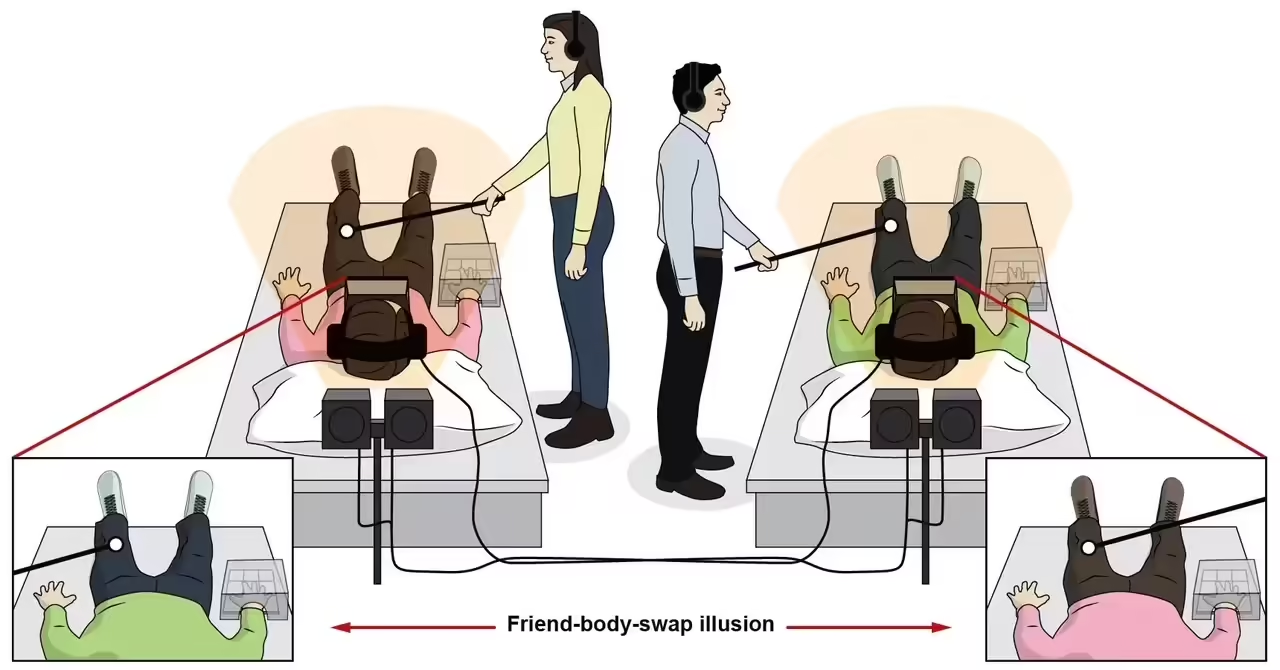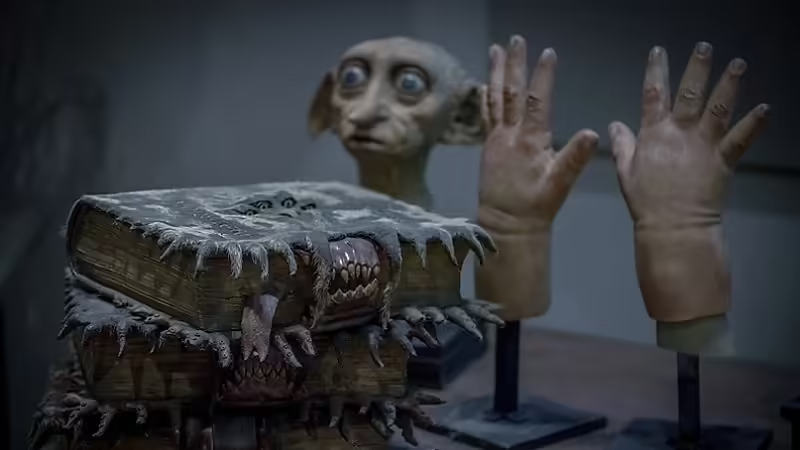
The concept of two individuals temporarily swapping their bodies has been a recurring theme in numerous movies and novels, often portrayed as a fantastical and purely fictional idea. However, recent advancements in neuroscience and technology are challenging the boundaries between science and science fiction, bringing us closer to the possibility of experiencing an out-of-body illusion.
The Fantasy of Body Swapping in Fiction
For decades, body swapping has been a popular theme in science fiction and fantasy literature. Stories like “Freaky Friday” and “The Change-Up” have entertained audiences with the humorous and often chaotic consequences of individuals inhabiting each other’s bodies. These fictional portrayals have captivated our imaginations and fueled the desire to explore what it would truly be like to experience life from a different physical perspective.
The Neuroscience Behind the Illusion
Recent breakthroughs in neuroscience have brought us closer to realizing the dream of body swapping. Researchers at the Karolinska Institute have developed technology that can trick the brain into perceiving an out-of-body experience. This achievement relies on a deep understanding of the brain’s sensory perception and the integration of visual, tactile, and proprioceptive information.
By using virtual reality and sensory manipulation, scientists have been able to create a convincing illusion of an out-of-body experience. This technology involves presenting individuals with a view of their own body from a third-person perspective, coupled with synchronized tactile sensations and visual feedback. The brain’s ability to adapt and integrate this conflicting information results in the sensation of being outside one’s own body.
Applications Beyond Entertainment
While the concept of body swapping remains a fascination in entertainment, the potential applications of this technology go far beyond mere amusement. Researchers are exploring therapeutic uses, such as helping individuals with body image disorders or providing new perspectives for empathy and understanding.
Additionally, in fields like robotics and telemedicine, the ability to remotely inhabit a robotic body or conduct delicate operations from a distance could have significant implications. The blending of technology and neuroscience is opening up exciting possibilities that could revolutionize how we interact with the world.
The Ethical and Philosophical Questions
As we delve deeper into the realm of body swapping, ethical and philosophical questions arise. What are the moral implications of inhabiting another person’s body, even if it’s only an illusion? How might this technology affect our sense of self and identity? These questions challenge us to consider the profound impact of merging science and fiction.
Development of Technology: Creating the Illusion of Body Swapping
In the realm of science and technology, there are few concepts as captivating and thought-provoking as the idea of body swapping. The notion of two individuals exchanging their physical identities, even temporarily, has long been a staple of science fiction and fantasy narratives. From novels to movies, this concept has tantalized our imaginations and left us wondering what it would truly be like to step into someone else’s shoes, or rather, someone else’s body. While the full-fledged body-swapping depicted in these fictional tales remains firmly in the realm of fantasy, recent advancements in technology and neuroscience have brought us closer to experiencing a form of this phenomenon—the illusion of body swapping.
The Fictional Allure of Body Swapping
Before diving into the technological advancements, let’s first explore why the idea of body swapping has resonated so deeply within popular culture. For years, it has been a recurring theme in literature and cinema, with works like “Freaky Friday,” “The Hot Chick,” and “Your Name” offering humorous and often poignant portrayals of characters switching bodies. These stories have allowed us to vicariously experience the hilarity and challenges that arise when two individuals find themselves in each other’s physical forms. They’ve also touched on deeper themes such as identity, empathy, and the importance of understanding others’ perspectives.
The Neuroscience Behind the Illusion
What sets the recent developments in body swapping apart from the realm of fiction is their foundation in neuroscience and technology. Researchers, particularly those at institutions like the Karolinska Institute, have made significant strides in understanding the intricacies of sensory perception and the brain’s remarkable ability to adapt to novel situations.
At the heart of this technological breakthrough is the creation of an illusion—an illusion of an out-of-body experience. By utilizing virtual reality and sensory manipulation, scientists have devised a way to trick the brain into believing that one’s consciousness is located outside of their physical body. This process involves presenting individuals with a view of their own body from a third-person perspective, coupled with synchronized tactile sensations and visual feedback. The brain, in its incredible adaptability, integrates this conflicting information, leading to the sensation of being detached from one’s own body.
Beyond Entertainment: Practical Applications
While the allure of body swapping technology for entertainment purposes is undeniable, its potential goes well beyond the realm of amusement. Researchers are actively exploring a range of applications, some of which could have transformative impacts on various fields.
For instance, the technology holds promise in therapeutic contexts. Individuals with body image disorders could use this technology to gain new perspectives on their own bodies, potentially aiding in their recovery. Moreover, it could be employed to foster empathy and understanding by allowing individuals to temporarily experience life from a different physical standpoint.
In domains like robotics and telemedicine, body swapping technology has the potential to revolutionize the way we interact with the physical world. Imagine remotely controlling a robot as if it were your own body or conducting delicate surgeries from a distant location. These applications, while still in their infancy, showcase the far-reaching implications of merging technology and neuroscience.
Body Swapping in Contemporary Literature and Cinema: Analyzing How Modern Depictions are Shaped by Current Scientific Advancements
The theme of body swapping, a staple of science fiction and fantasy, has long captivated audiences in literature and cinema. However, contemporary portrayals of body swapping have evolved, reflecting the influence of cutting-edge scientific advancements.
Body Swapping: A Timeless Fantasy
The concept of individuals switching bodies, often leading to comedic or thought-provoking scenarios, has a rich history in storytelling. Classic works like “Freaky Friday” and “The Change-Up” have entertained generations with their humorous take on this premise. Yet, as science and technology advance, so too do our portrayals of body swapping.
From Fiction to Reality: Scientific Advancements
Advances in neuroscience and virtual reality technology have played a pivotal role in redefining our understanding of body swapping. Recent research has explored the brain’s capacity to adapt to sensory mismatches, creating the illusion of being in another person’s body. This scientific progress has fueled a shift in how contemporary literature and cinema depict body swapping, moving away from pure fantasy towards a more scientifically informed narrative.
The Influence of Neuroscience on Modern Storytelling
Modern storytelling now incorporates elements of neuroscience to make body swapping narratives more plausible. Characters grapple with the intricacies of sensory perception and the challenges of inhabiting a different physical form. These narratives are not just comedic escapades but also offer thought-provoking explorations of identity, empathy, and the impact of technology on human experience.
Virtual Reality and Cinematic Realism
In cinema, the use of virtual reality technology has allowed for more immersive and visually convincing depictions of body swapping. Viewers are transported into the characters’ experiences, witnessing firsthand the disorientation and wonder of inhabiting another body. This technological leap enhances the storytelling and engages audiences on a deeper level.
Expanding Themes: Ethical and Philosophical Complexities
Contemporary portrayals of body swapping also delve into the ethical and philosophical complexities of the phenomenon. As scientific advancements bring us closer to the possibility of out-of-body illusions, characters grapple with questions of identity, consent, and the consequences of altering one’s physical form. These themes add depth and resonance to the narratives.
Stories of Individuals Who Experienced Lasting Changes: Real Testimonials from Those Affected by Long-Term Effects of Body Swap Experiences
As we delve into the profound and enduring effects of simulated body swap experiences on individual psychology, it is essential to explore real-life stories of those who have undergone these extraordinary encounters. This section presents personal testimonials from individuals who have experienced long-lasting transformations, shedding light on the profound impact these experiences can have on one’s sense of self and perspective.
Lucy’s Journey to Self-Acceptance
Lucy, a 28-year-old artist, struggled for years with low self-esteem and a negative body image. Her participation in a simulated body swap experience, where she inhabited the body of a professional athlete, provided her with a unique perspective. Lucy’s testimony reveals how this experience challenged her preconceptions about beauty and athleticism, leading to a newfound sense of self-acceptance and a healthier relationship with her body.
“The experience made me realize that strength and beauty come in many forms. I no longer view my body with criticism but with appreciation for what it can do.”
Mike’s Empathy-Driven Transformation
Mike, a middle-aged executive, embarked on a simulated body swap journey that allowed him to inhabit the body of a person with a physical disability. This experience deeply affected his outlook on life and his interactions with others. In his testimony, Mike reflects on how the encounter instilled in him a profound sense of empathy and a commitment to promoting inclusivity in both his personal and professional life.
“Experiencing the challenges of navigating the world with a disability changed me fundamentally. I’ve become an advocate for accessibility and inclusivity, and it’s transformed the way I relate to others.”
Maria’s Altered Perspective on Identity
Maria, a college student studying sociology, engaged in a simulated body swap experience that led her to temporarily inhabit the body of someone from a different cultural background. This encounter had a lasting impact on her perception of identity and cultural diversity. Maria’s story illustrates how the experience fostered a more inclusive and open-minded approach to understanding people from diverse backgrounds.
“Stepping into someone else’s shoes, quite literally, made me realize the richness of human diversity. It’s influenced my academic pursuits and my commitment to promoting cultural understanding.”
David’s Journey to Overcoming Social Anxiety
David, a young professional, battled social anxiety for years before participating in a body swap experience that allowed him to temporarily inhabit the body of an extroverted and confident individual. In his heartfelt testimony, David shares how the experience acted as a catalyst for personal growth, empowering him to confront his anxiety and become more socially outgoing.
“The experience gave me a taste of what life could be like without the constant weight of anxiety. It was a turning point in my life, and I’ve since made incredible strides in overcoming my social fears.”







